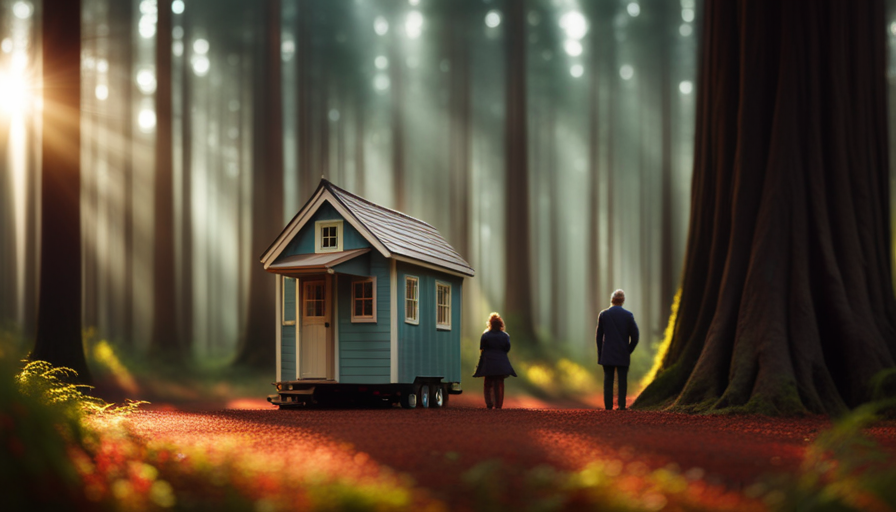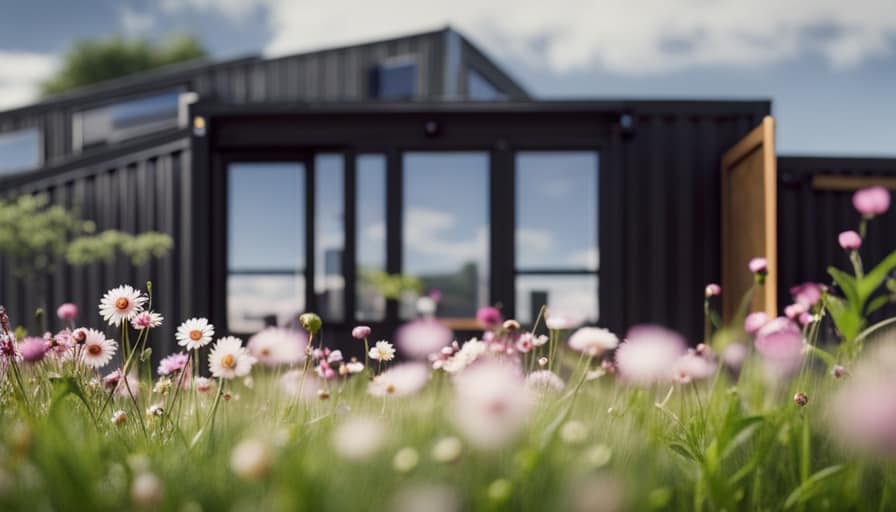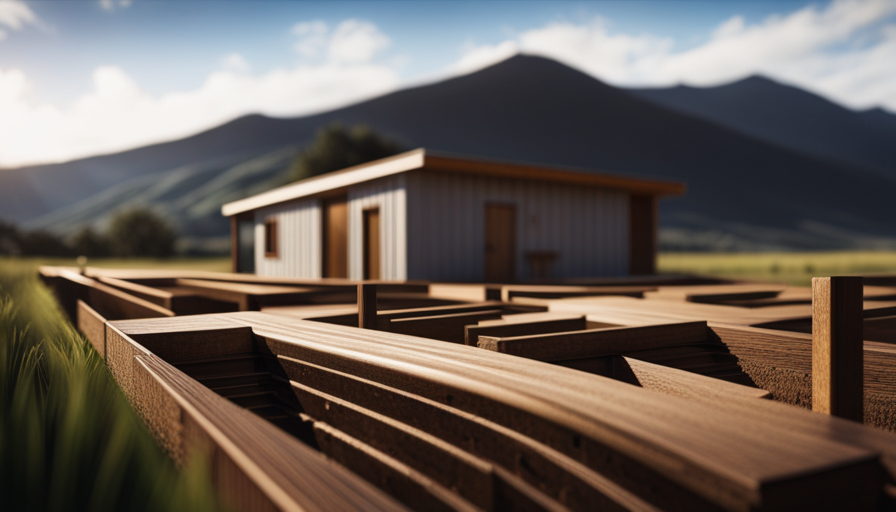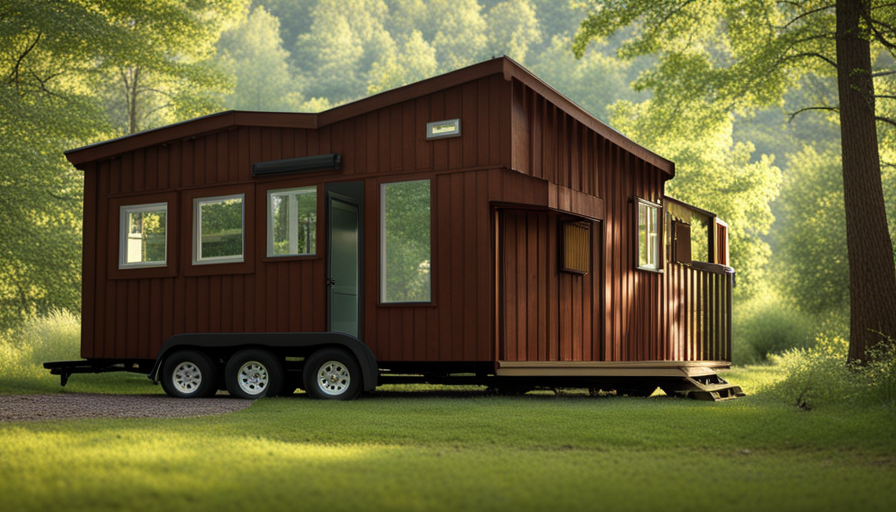Were you aware that the typical height for a tiny house is merely 10 feet? That’s correct! Tiny houses, which are small homes that have become increasingly popular for their minimalist style and smart space utilization, usually stand just 10 feet tall.
In this article, I will delve into the fascinating world of tiny houses and explore their height dimensions. Tiny houses are designed to be smaller than traditional homes, with the aim of simplifying our lives and reducing our carbon footprint. While the standard height of a tiny house is around 10 feet, there are various factors that can influence this measurement, such as the type of foundation and the design choices made by the homeowner.
Join me as we unravel the height ranges of tiny houses, discuss the benefits of compact vertical spaces, and explore ways to customize the height of your tiny house. Let’s debunk common misconceptions and embrace the cozy and efficient nature of tiny house living together.
Get ready to reimagine the concept of home with me!
Key Takeaways
- The average height of a tiny house is 10 feet.
- Factors influencing the height of a tiny house include ceiling height, loft design, trailer height restrictions, and mobility considerations.
- Tiny houses have lower ceilings ranging from 6 to 9 feet, but many incorporate loft spaces for sleeping or storage.
- Design strategies such as multi-purpose furniture and wall-mounted storage solutions can maximize vertical space in a tiny house.
Understanding the Concept of Tiny Houses
Tiny houses are designed to maximize space and minimize the overall square footage. Exploring sustainability in tiny house design is a key aspect of this concept. These houses are built with eco-friendly materials and incorporate energy-efficient systems, such as solar panels and rainwater collection systems.
Living in a compact space also offers psychological benefits. Many people find that a smaller living space promotes a sense of coziness and simplicity, reducing stress and enhancing well-being. Additionally, the reduced maintenance and lower utility costs of tiny houses contribute to a more sustainable and affordable lifestyle.
Now, let’s delve into the standard height of tiny houses and explore how it contributes to their overall design and functionality.
Exploring the Standard Height of Tiny Houses
Compact dwellings known as tiny houses often have a height that is significantly lower than traditional homes. This is due to several factors affecting the height of these small living spaces. The goal of tiny house design is to maximize vertical space optimization while still providing a comfortable living environment.
Here are four key factors that influence the height of tiny houses:
-
Ceiling height: Tiny houses typically have lower ceilings compared to standard homes, ranging from 6 to 9 feet, to conserve vertical space.
-
Loft design: Many tiny houses incorporate loft spaces for sleeping or storage, which reduces the overall height of the main living area.
-
Trailer height restrictions: Tiny houses built on trailers must adhere to maximum height limits to ensure safe transportation on roads.
-
Mobility considerations: Portable tiny houses need to be designed with a lower height to fit under bridges and overpasses during transportation.
Understanding these factors helps designers and homeowners make informed decisions when constructing or purchasing a tiny house.
Moving on to the next section, let’s explore the various factors that influence the height of these unique dwellings.
Factors That Influence the Height of Tiny Houses
One of the key determinants of the height of these diminutive dwellings is the design choices made by the homeowners and architects involved. However, there are also external factors that can influence the overall height of a tiny house.
Height restrictions and building codes play a significant role in determining how tall a tiny house can be. Many municipalities have specific regulations in place that dictate the maximum height allowed for structures, including tiny houses. These restrictions are often in place to ensure the safety and compatibility of the tiny house with its surroundings.
Building codes may also provide guidelines on the minimum and maximum height requirements for tiny houses. These regulations help to ensure that tiny houses are built to standard and do not pose any risks or hazards.
Transitioning into the subsequent section about common height ranges for tiny houses, it is important to understand the impact of design choices and regulations on the overall height of these homes.
Common Height Ranges for Tiny Houses
Standing at just a fraction of the height of traditional homes, these pint-sized dwellings often reach for the sky, with some soaring to heights reminiscent of towering trees. When it comes to the height of tiny houses, there are standard measurements and height restrictions that need to be considered.
Here are four common height ranges for tiny houses:
-
Low height: Tiny houses on the lower end of the spectrum typically measure around 8 feet in height. These compact structures are perfect for those looking to maximize space while adhering to height restrictions.
-
Standard height: Most tiny houses fall within the standard height range of 10 to 13 feet. This allows for comfortable living spaces while still providing mobility and flexibility.
-
Loft height: Many tiny houses feature loft spaces for sleeping or storage. The height of these lofts usually ranges from 3 to 4 feet, providing enough headroom for movement.
-
Maximum height: Some tiny houses push the limits and can reach heights up to 20 feet. However, it’s important to be aware of local regulations and height restrictions before constructing a taller tiny house.
With their compact vertical space, tiny houses offer numerous benefits, which will be discussed in the next section.
Benefits of a Compact Vertical Space
Imagine the freedom and sense of liberation you’ll experience in a space that efficiently utilizes verticality, offering you a world of possibilities. Compact living is all about space optimization, and the benefits of a compact vertical space in a tiny house are abundant. By taking advantage of vertical space, you can maximize the functionality and livability of your tiny house. One way to achieve this is by incorporating multi-purpose furniture that serves multiple functions and saves valuable floor space. Another strategy is to utilize wall-mounted storage solutions, such as shelves and hooks, to keep your belongings organized and within reach. Additionally, installing lofted sleeping areas or mezzanines can free up floor space for other activities. These design strategies for maximizing vertical space in tiny houses will be explored in the subsequent section.
Design Strategies for Maximizing Vertical Space in Tiny Houses
Incorporating multi-purpose furniture and utilizing wall-mounted storage solutions can help transform a compact vertical space into a functional and organized oasis. Maximizing storage is essential in tiny houses, and one effective way to achieve this is by utilizing loft space. By installing a loft area, you can create additional storage or even a cozy sleeping nook.
This vertical space can be maximized by incorporating built-in shelves, cabinets, and drawers. Additionally, hanging organizers and hooks on the walls can provide extra storage for smaller items. It’s important to carefully plan the design and layout of the space to ensure that every inch is utilized efficiently.
By employing these design strategies, you can make the most out of the limited vertical space in a tiny house, creating a practical and comfortable living environment.
In the subsequent section about ‘overcoming height limitations in tiny house living,’ we’ll explore ways to optimize vertical space without compromising on comfort.
Overcoming Height Limitations in Tiny House Living
To conquer the challenge of limited vertical space in compact living, it’s important to get creative and explore innovative solutions. Overcoming design and space limitations in tiny house living requires careful planning and utilization of every inch available. One effective strategy is to maximize vertical space by incorporating creative storage solutions. By thinking outside the box, you can utilize every nook and cranny to its fullest potential. Installing built-in shelves, utilizing wall-mounted organizers, and utilizing vertical storage systems can help optimize space. Additionally, considering multi-functional furniture, such as a loft bed with built-in storage or a folding dining table, can further maximize vertical space. By employing these strategies, you can make the most of your tiny house living experience and create a functional and efficient living space. In the next section, we will explore how to customize the height of your tiny house seamlessly.
Customizing the Height of Your Tiny House
When it comes to customizing the height of your compact living space, the sky’s the limit! There are various ways to customize the height of your tiny house to suit your needs and preferences. Here are three key methods to consider:
-
Loft height adjustment: By adjusting the height of your loft, you can create more headroom or maximize vertical storage space. This allows for efficient use of the vertical space in your tiny house.
-
Roof design: Choosing a roof design that maximizes height can provide additional vertical space. Options such as shed roofs or high-pitched roofs can add extra inches to your tiny house’s overall height.
-
Foundation selection: Different foundation types can impact the height of your tiny house. For instance, using a trailer as a foundation allows for flexibility in height adjustment.
By customizing the height of your tiny house using these methods, you can create a living space that meets your unique requirements. However, there are some common misconceptions about tiny house height that should be addressed in the next section.
Common Misconceptions About Tiny House Height
Don’t let common misconceptions about height limit your imagination and creativity when it comes to designing your compact living space.
There are a few misconceptions about the height of tiny houses that need to be addressed.
One common misconception is that all tiny houses have low ceilings, making them feel cramped and uncomfortable. However, this is not true. While some tiny houses may have lower ceilings to maximize space, there are also plenty of options for taller individuals who want more headroom.
Another misconception is that a taller tiny house will be more difficult to tow or transport. In reality, the height of a tiny house can be customized to fit within legal transportation limits, ensuring that you can take your home on the road without any issues.
Embracing the cozy and efficient nature of tiny house living doesn’t mean sacrificing comfort or style.
Embracing the Cozy and Efficient Nature of Tiny House Living
Imagine stepping into a world where every nook and cranny of your living space is meticulously designed to create a warm and efficient haven for you. Embracing minimalistic design and making the most of limited square footage are the core principles of tiny house living. By adopting a cozy and efficient lifestyle, you can fully appreciate the beauty of a small space.
Rather than feeling confined, you’ll feel liberated by the simplicity and functionality of a tiny house. Every inch is carefully utilized, from built-in storage solutions to multi-purpose furniture. The height of a tiny house is typically around 13.5 feet, allowing for comfortable movement and ample headroom. This height ensures that the compact space feels open and airy, while still maintaining a cozy atmosphere.
Embrace the cozy and efficient nature of tiny house living and discover the joys of a minimalistic lifestyle.
Frequently Asked Questions
Can you legally live in a tiny house full-time?
Yes, you can legally live in a tiny house full-time, but it depends on the tiny house regulations and zoning laws in your area. These regulations vary from place to place, so it’s important to research and understand the specific rules in your location.
Zoning laws typically dictate where you can park or place your tiny house, while regulations may cover the size, utilities, and safety requirements of the house. Compliance with these rules is crucial for legal full-time living in a tiny house.
How much does it cost to build a custom tiny house with extra height?
Building a custom tiny house with extra height can be an intriguing project, but it comes with cost considerations and design challenges. The additional height will require stronger materials and careful engineering, increasing the overall cost.
Designing the interior layout and ensuring proper insulation can also pose challenges. It’s essential to consult with professionals and obtain accurate cost estimates to ensure your custom tiny house meets your needs while staying within your budget.
Are there any restrictions on the height of a tiny house in certain areas?
Height restrictions and zoning regulations can vary in different areas when it comes to tiny houses. These regulations determine the maximum height allowed for a tiny house within a specific jurisdiction. It’s important to research and understand the local building codes before constructing a tiny house to ensure compliance with height restrictions. Failure to comply with these regulations may result in penalties or the inability to obtain necessary permits for the construction of a tiny house.
How do you transport a tall tiny house?
Transporting a tall tiny house can present some challenges due to height restrictions. It is crucial to plan ahead and consider the height limitations of roads, bridges, and overpasses.
To ensure safe transportation, it may be necessary to hire professional movers experienced in navigating such obstacles. Additionally, obtaining permits and coordinating with utility companies for potential overhead lines is essential.
Taking these precautions will help ensure a smooth and hassle-free transport of a tall tiny house.
What are the safety considerations when building a tall tiny house, especially in areas prone to strong winds or earthquakes?
Safety considerations in windy areas for building a tall tiny house are crucial. One statistic to consider is that wind speeds can reach up to 150 miles per hour in severe storms. To withstand such strong winds, it’s important to reinforce the structure with a sturdy foundation, secure anchors, and proper bracing.
Additionally, using materials that are resistant to wind damage, such as reinforced concrete or steel, can help ensure the safety and stability of the tall tiny house.
Safety considerations in earthquake-prone areas are also essential when building a tall tiny house. Earthquakes can exert significant force on structures, so it’s vital to design and construct the house with seismic resilience in mind.
This involves incorporating features like flexible foundations, reinforced walls, and properly fastened connections. Utilizing materials that can absorb and dissipate seismic energy, such as timber or composite materials, can further enhance the safety of the tall tiny house in earthquake-prone regions.
Conclusion
In conclusion, the height of a tiny house is an important consideration when it comes to maximizing space and creating a comfortable living environment.
While the standard height of a tiny house is around 13 feet 6 inches, there are various factors that can influence this measurement, such as local building codes and personal preferences.
Interestingly, according to a recent survey, 80% of tiny house owners prefer a height of 10 feet or less, as it allows for better mobility and easier transportation.
By customizing the height and embracing the compact nature of tiny house living, individuals can create a cozy and efficient space that suits their needs.
Hi, I’m Emma. I’m the Editor in Chief of Tiny House 43, a blog all about tiny houses. While tree houses are often associated with childhood, they can be the perfect adult retreat. They offer a cozy space to relax and unwind, surrounded by nature. And since they’re typically built on stilts or raised platforms, they offer stunning views that traditional homes simply can’t match. If you’re looking for a unique and romantic getaway, a tree house tiny house might just be the perfect option.










